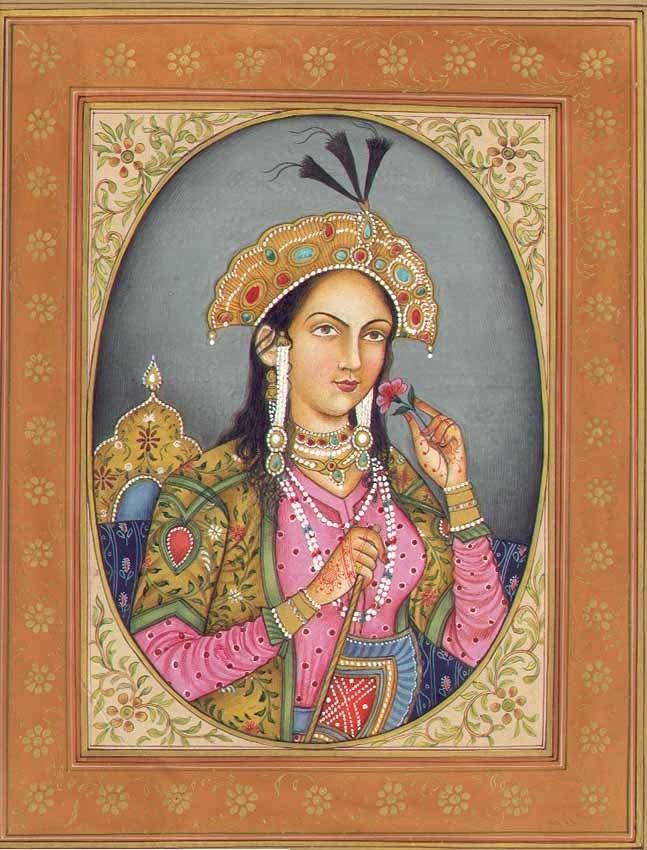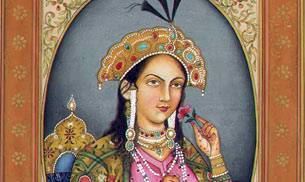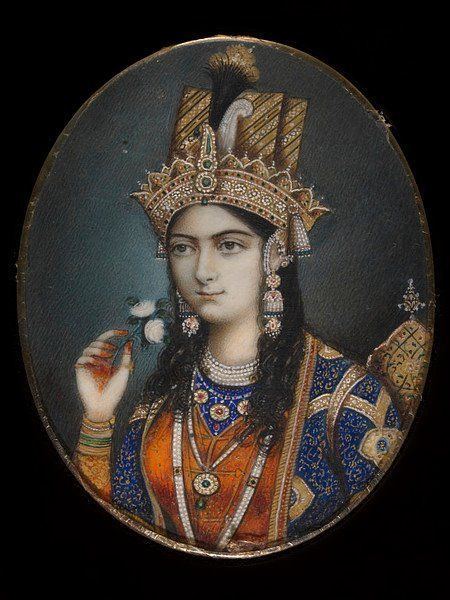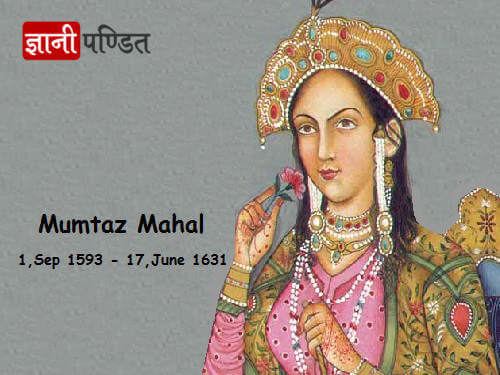Name Mumtaz Mahal | Aunts Nur Jahan | |
 | ||
Tenure 8 November 1627 – 17 June 1631 Tenure 8 November 1627 – 17 June 1631 Children Aurangzeb, Jahanara Begum, Dara Shikoh Siblings Shaista Khan, Parwar Khanum, Farzana Begum Similar People | ||
Interesting facts about Mumtaz Mahal
Mumtaz Mahal ([mumˈt̪aːz mɛˈɦɛl]; meaning "the Exalted One of the palace"; born Arjumand Banu) (27 April 1593 – 17 June 1631) was Empress consort of the Mughal Empire from 19 January 1628 to 17 June 1631 as the chief consort of the Mughal emperor Shah Jahan. The UNESCO World Heritage Site, Taj Mahal in Agra, often cited as one of the Wonders of the World, was commissioned by her husband to act as her final resting place.
Contents
- Interesting facts about Mumtaz Mahal
- Mumtaz mahal mp4
- Family and early life
- Marriage
- Mughal empress
- Death and aftermath
- The Taj Mahal
- In popular culture
- References
Mumtaz Mahal was born Arjumand Banu Begum in Agra to a family of Persian nobility. She was the daughter of Abu'l-Hasan Asaf Khan, a wealthy Persian noble who held high office in the Mughal Empire, and the niece of Empress Nur Jahan, the chief wife of Emperor Jahangir and the power behind the emperor. She was married at the age of 19 on 30 April 1612 to Prince Khurram, later known by his regnal name Shah Jahan, who conferred upon her the title "Mumtaz Mahal". Although betrothed to Shah Jahan since 1607, she ultimately became his second wife in 1612. Mumtaz bore her husband fourteen children, including Jahanara Begum (Shah Jahan's favourite daughter), and the Crown prince Dara Shikoh, the heir-apparent, anointed by his father, who temporarily succeeded him, until deposed by Mumtaz Mahal's sixth child, Aurangzeb, who ultimately succeeded his father as the sixth Mughal emperor.
Mumtaz Mahal died in 1631 in Burhanpur, Deccan (present-day Madhya Pradesh), during the birth of her fourteenth child, a daughter named Gauhara Begum. Shah Jahan had the Taj Mahal built as a mausoleum for her, which is considered to be a monument of "undying love".

Mumtaz mahal mp4
Family and early life

Mumtaz Mahal was born Arjumand Banu Begum on 27 April 1593 in Agra to Abu'l-Hasan Asaf Khan and his wife Diwanji Begum, the daughter of a Persian noble, Khwaja Ghias-ud-din of Qazvin. Asaf Khan was a wealthy Persian noble who held high office in the Mughal Empire. His family had come to India impoverished in 1577, when his father Mirza Ghias Beg (popularly known by his title of I'timad-ud-Daulah), was taken into the service of Emperor Akbar in Agra.

Asaf Khan was also the older brother of Empress Nur Jahan, making Mumtaz a niece, and later, a stepdaughter-in-law of Nur Jahan, the chief consort of Emperor Jahangir, Shah Jahan's father. Her older sister, Parwar Khanum, married Sheikh Farid, the son of Nawab Qutubuddin Koka, the governor of Badaun, who was also the emperor Jahangir's foster brother. Mumtaz also had a brother, Shaista Khan, who served as the governor of various provinces in the empire during Shah Jahan's reign.

Mumtaz was remarkable in the field of learning and was a talented and cultured lady. She was well-versed in Arabic and Persian languages and could compose poems in the latter. She was a rare combination of modesty and candor, a woman warmly straightforward yet bemusedly self-possessed. Early in adolescence, she attracted the attention of important nobles of the realm. Jahangir must've heard about her, since he readily consented to Shah Jahan's engagement with her.
Marriage

Mumtaz Mahal was betrothed to Shah Jahan c. 30 January 1607, when she was 13 years old at the time and he was 15. They were, however, married five years after the year of their betrothal on 30 April 1612 in Agra. The marriage was a love-match. After their wedding celebrations, Shah Jahan, "finding her in appearance and character elect among all the women of the time", gave her the title "Mumtaz Mahal" Begum ("the Exalted One of the Palace"). During the intervening years between their betrothal and marriage, Shah Jahan had gotten married to his first wife, Kandahari Begum (a Safavid princess) in 1609 and in 1617, after marrying Mumtaz, took a third wife, Izz-un-Nissa (titled Akbarabadi Mahal), the daughter of a prominent Mughal courtier. According to the official court historians, both the marriages were political alliances.
By all accounts, Shah Jahan was so taken with Mumtaz that he showed little interest in exercising his polygamous rights with his two other wives, other than dutifully siring a child with each. According to the official court chronicler, Motamid Khan, as recorded in his Iqbal Namah-e-Jahangiri, the relationship with his other wives "had nothing more than the status of marriage. The intimacy, deep affection, attention and favour which His Majesty had for the Cradle of Excellence [Mumtaz] exceeded by a thousand times what he felt for any other." Likewise, Shah Jahan's historian Inayat Khan commented that 'his whole delight was centered on this illustrious lady [Mumtaz], to such an extent that he did not feel towards the others [i.e. his other wives] one-thousandth part of the affection that he did for her.'
Mumtaz had a loving marriage with Shah Jahan. Even during her lifetime, poets would extol her beauty, grace, and compassion. Despite her frequent pregnancies, Mumtaz travelled with Shah Jahan's entourage throughout his earlier military campaigns and the subsequent rebellion against his father. She was his constant companion and trusted confidant, leading court historians to go to unheard lengths to document the intimate and erotic relationship the couple enjoyed. In their nineteen years of marriage, they had fourteen children together (eight sons and six daughters), seven of whom died at birth or at a very young age.
Mughal empress
Upon his accession to the throne in 1628, Shah Jahan designated Mumtaz as his chief empress with the title of 'Malika-i-Jahan' ("Queen of the World") and 'Malika-uz-Zamani' ("Queen of the Age"). Mumtaz's tenure as empress was brief (spanning a period of only three years due to her untimely death), nonetheless Shah Jahan bestowed her with luxuries that no other empress was given before her. For example, no other empress' residence was as decorated as Khas Mahal (part of Agra Fort), where Mumtaz lived with Shah Jahan. It was decorated with pure gold and precious stones and had rose water fountains of its own. Each wife of the Mughal emperor was given regular monthly allowance for her gastos (housekeeping or travelling expenses). The highest allowance on record is 10 lakh rupees per year given to Mumtaz Mahal under Shah Jahan.
Shah Jahan consulted Mumtaz in both private matters and the affairs of the state and she served as his close confidante and trusted adviser. At her intercession, he forgave enemies or commuted death sentences. His trust in her was so great that he gave her the highest honour of the land — his imperial seal, the Mehr Uzaz, which validated imperial decrees. Mumtaz was portrayed as having no aspirations to political power, in contrast to her aunt, Empress Nur Jahan, the chief consort of Emperor Jahangir, who had wielded considerable influence in the previous reign.
A great influence on him, often intervening on behalf of the poor and destitute, she also enjoyed watching elephant and combat fights performed for the court. Mumtaz also patronized a number of poets, scholars and other talented persons. A noted Sanskrit poet, Vansidhara Mishra, was the Empress' favourite. On the recommendation of her principal lady-in-waiting, Sati-un-Nissa, Mumtaz Mahal provided pensions and donations to the daughters of poor scholars, theologians, and pious men. It was quite common for women of noble birth to commission architecture in the Mughal Empire, so Mumtaz devoted some time to a riverside garden in Agra, which is now known as Zahara Bagh. It is the only architectural foundation which can be connected to her patronage.
Death and aftermath
Mumtaz Mahal died in Burhanpur on 17 June 1631 while giving birth to her fourteenth child. She had been accompanying her husband while he was fighting a campaign in the Deccan Plateau. Her body was temporarily buried at Burhanpur in a walled pleasure garden known as Zainabad originally constructed by Shah Jahan's uncle Daniyal on the bank of the Tapti River. The contemporary court chroniclers paid an unusual amount of attention to Mumtaz Mahal's death and Shah Jahan's grief at her demise. In the immediate aftermath of his bereavement, the emperor was reportedly inconsolable. Apparently after her death, he went into secluded mourning for a year. When he appeared again, his hair had turned white, his back was bent, and his face worn. Mumtaz's eldest daughter, Jahanara Begum, gradually brought her father out of grief and took her mother's place at court.
Her personal fortune (valued at ten million rupees) was divided by Shah Jahan between Jahanara Begum, who received half and the rest of her surviving children. Burhanpur was never intended by her husband as his wife's final resting spot. As a result, her body was disinterred in December 1631 and transported in a golden casket escorted by her son Shah Shuja and the deceased Empress' head lady-in-waiting back to Agra. There it was interred in a small building on the banks of the Yamuna River. Shah Jahan stayed behind in Burhanpur to conclude the military campaign that had originally brought him to the region. While there, he began planning the design and construction of a suitable mausoleum and funerary garden in Agra for his wife. It was a task that would take 22 years to complete: the Taj Mahal.
The Taj Mahal
The Taj Mahal was commissioned by Shah Jahan to be built as a mausoleum for Mumtaz Mahal. It is seen as an embodiment of undying love and marital devotion. English poet, Sir Edwin Arnold describes it as "Not a piece of architecture, as other buildings are, but the proud passion of an emperor's love wrought in living stones." The beauty of the monument is also taken as a representation of Mumtaz Mahal's beauty and this association leads many to describe Taj Mahal as feminine. Since Muslim tradition forbids elaborate decorations on graves, the bodies of Mumtaz and Shah Jahan are placed in a relatively plain crypt beneath the inner chamber with their faces turned right and towards Mecca.
The Ninety Nine Names of God are found as calligraphic inscriptions on the sides of the tomb of Mumtaz Mahal in the crypt including, “O Noble, O Magnificent, O Majestic, O Unique, O Eternal, O Glorious…". There are many theories about the origin of the name of this tomb and one of them suggests that 'Taj' is an abbreviation of the name Mumtaz. European travelers, such as François Bernier, who observed its construction, were among the first to call it the Taj Mahal. Since it is unlikely that they came up with the name, it is suggested that they might have picked it up from the locals of Agra who called the Empress 'Taj Mahal' and thought the tomb was named after her and the name began to be used interchangeably. However, there is no firm evidence to suggest this. Shah Jahan had not intended to entomb another person in the Taj Mahal; however, Aurangzeb had Shah Jahan buried next to the tomb of Mumtaz Mahal rather than build a separate tomb for his father. This is evident from the asymmetrical placement of Shah Jahan's grave on one side of his wife's grave which is in the centre.
In popular culture
A crater was named in her honour on asteroid 433 Eros, along with another one after her husband.
